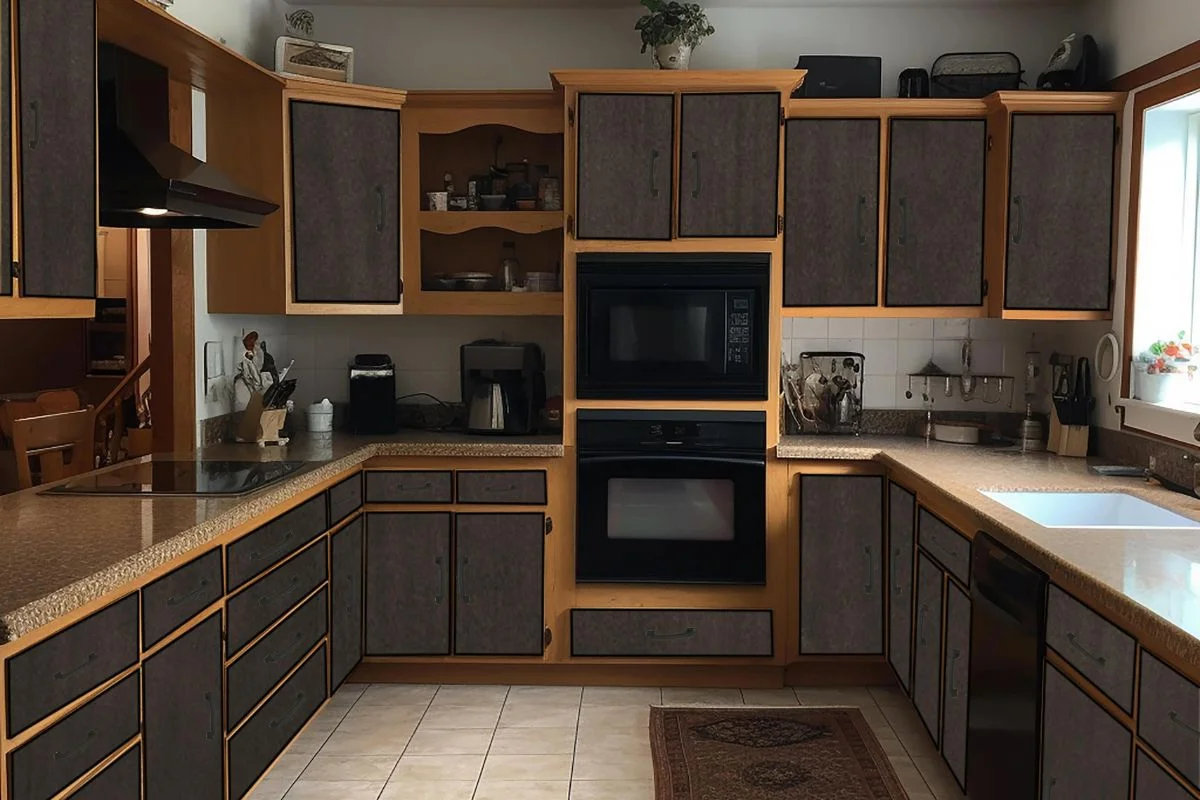
Your kitchen is more than just a place where meals are prepared; it’s the heart of your home, a hub of activity, and a space for gathering with family and friends. When it comes to transforming your kitchen, custom carpentry offers endless possibilities to elevate both the functionality and aesthetics of this essential space.
In this blog, we’ll explore the art of custom carpentry in kitchen design, offering insightful tips and inspiring ideas to help you create a culinary haven that reflects your personal style and meets your practical needs. Whether you’re renovating an existing kitchen or starting from scratch, the right carpentry solutions can truly make a difference, maximizing space, optimizing storage, and adding a touch of sophistication to your home.
Join us on a journey through the world of custom kitchen carpentry, where creativity meets craftsmanship to bring your dream kitchen to life.
Brief overview of the importance of kitchen carpentry:
Kitchen carpentry plays a pivotal role in both the functionality and aesthetics of any kitchen space. From custom cabinets to intricate details like trim and molding, carpentry brings a unique blend of practicality and style to the heart of the home. By maximizing storage space, optimizing workstations, and enhancing visual appeal, kitchen carpentry transforms mundane kitchens into personalized culinary havens. Whether it’s through tailored storage solutions or decorative accents, the art of kitchen carpentry adds value and charm to any home, making it a vital component of modern kitchen design.
Definition and scope of kitchen carpentry:
Kitchen carpentry encompasses the design, fabrication, and installation of wooden elements within a kitchen space, aimed at enhancing both its functionality and aesthetic appeal. This specialized branch of carpentry focuses on creating custom solutions tailored to the unique needs and preferences of each homeowner. From cabinetry and countertops to trim work and decorative details, kitchen carpentry covers a wide range of elements that contribute to the overall design and layout of a kitchen. It involves utilizing various woodworking techniques and materials to craft durable and visually pleasing components that optimize storage, workspace efficiency, and visual harmony within the kitchen environment. Overall, kitchen carpentry plays a crucial role in transforming ordinary kitchens into personalized and inviting spaces for cooking, dining, and gathering.
Types of carpentry solutions commonly used in kitchen design:
Custom Cabinetry: Custom-built cabinets are a staple of kitchen carpentry, offering tailored storage solutions that maximize space and organization. These cabinets can be designed to fit specific dimensions and layouts, incorporating features like pull-out shelves, drawer dividers, and hidden compartments to optimize functionality.
Kitchen Islands: Kitchen islands are versatile carpentry solutions that serve as focal points in modern kitchen designs. They provide additional workspace, storage, and seating options, often featuring custom-built cabinetry, countertops, and decorative details to complement the overall aesthetic of the kitchen.
Countertops and Surfaces: Carpentry extends to the fabrication and installation of countertops and other surfaces within the kitchen. From durable materials like granite and quartz to natural wood and butcher block, custom carpentry ensures that countertops are crafted to withstand the demands of daily use while enhancing the visual appeal of the kitchen.
Pantry Systems: Pantry systems are carpentry solutions designed to optimize storage for dry goods, canned items, and kitchen essentials. These may include custom-built pantry cabinets, pull-out shelves, wire racks, and door organizers, providing efficient storage solutions to keep the kitchen organized and clutter-free.
Decorative Details: Carpentry adds aesthetic flair to the kitchen through decorative details such as crown molding, trim work, and paneling. These elements enhance the visual appeal of cabinetry and architectural features, creating a cohesive and polished look that elevates the overall design of the kitchen.
Built-in Appliances: Kitchen carpentry often involves integrating built-in appliances seamlessly into the cabinetry and design scheme. This includes appliances such as refrigerators, dishwashers, ovens, and microwaves, which are strategically incorporated to optimize space and functionality while maintaining a cohesive aesthetic throughout the kitchen
Benefits of incorporating carpentry in kitchen renovation projects:
Customization: Carpentry allows for tailored solutions that can be customized to fit the specific layout, dimensions, and design preferences of each kitchen. This level of customization ensures that every aspect of the renovation project meets the homeowner’s unique needs and enhances the functionality of the space.
Optimal Space Utilization: By incorporating carpentry solutions such as custom cabinetry, kitchen islands, and pantry systems, homeowners can maximize the use of available space in their kitchens. Efficient storage options and strategically placed fixtures help to organize belongings and create a clutter-free environment, making the kitchen more functional and enjoyable to use.
Enhanced Aesthetics: Carpentry adds aesthetic appeal to kitchen renovation projects through the use of decorative details, quality materials, and expert craftsmanship. Custom-built cabinetry, countertops, and decorative elements create a cohesive and visually pleasing design scheme that reflects the homeowner’s style and enhances the overall ambiance of the kitchen.
Increased Property Value: A well-designed and professionally executed kitchen renovation, incorporating high-quality carpentry work, can significantly increase the value of a property. Potential buyers are often drawn to kitchens with custom features and modern amenities, making it a worthwhile investment for homeowners looking to sell their homes in the future.
Long-Term Durability: Carpentry solutions in kitchen renovation projects are built to last, using durable materials and construction techniques that withstand the rigors of daily use. Quality craftsmanship ensures that the renovation project maintains its functionality and aesthetic appeal for years to come, providing homeowners with a long-term return on their investment.
Personalization: Incorporating carpentry in kitchen renovation projects allows homeowners to express their personal style and preferences through custom design elements and finishes. Whether it’s choosing the perfect wood species for cabinetry or selecting decorative hardware and accents, carpentry offers endless opportunities for personalization to create a kitchen that truly reflects the homeowner’s tastes and lifestyle.
DIY vs. Professional Carpentry: Making the Right Choice
Assessing Skill Level: Consider your own carpentry skills and experience before deciding whether to tackle kitchen renovation projects on your own. While some DIY enthusiasts may have the necessary expertise to handle simple tasks like painting or installing shelves, more complex carpentry work such as cabinet building or countertop installation often requires professional knowledge and tools.
Time and Commitment: DIY projects can be time-consuming and may require a significant commitment of your time and energy. Consider whether you have the availability to dedicate to the project, as well as the patience to troubleshoot any issues that may arise along the way. Hiring a professional carpenter can save you time and hassle, allowing you to focus on other priorities while the renovation work is being completed.
Cost Considerations: While DIY projects may seem cost-effective upfront, they can often end up being more expensive in the long run if mistakes are made or if additional materials and tools are needed to correct errors. Professional carpenters have the expertise and resources to complete projects efficiently and effectively, potentially saving you money on unnecessary expenses.
Quality and Precision: Professional carpenters bring a level of skill and precision to their work that may be difficult to achieve through DIY efforts. From precise measurements and intricate detailing to seamless installation and finishing, hiring a professional ensures that your kitchen renovation project is completed to the highest standards of quality and craftsmanship.
Warranty and Guarantees: Many professional carpentry services offer warranties and guarantees on their workmanship, providing you with peace of mind and assurance that any issues will be promptly addressed and resolved. DIY projects typically do not come with such guarantees, leaving you responsible for any repairs or corrections that may be needed in the future.
Safety Considerations: Carpentry can involve working with heavy machinery, sharp tools, and potentially hazardous materials. Professional carpenters are trained in safety protocols and procedures to minimize the risk of accidents and injuries on the job. If you’re not confident in your ability to safely execute a DIY project, it’s best to leave it to the professionals to avoid any potential harm.
Maintenance Tip for Kitchen Carpentry Ideas:
Regular Cleaning and Maintenance: To keep your kitchen carpentry looking its best and functioning properly, it’s important to establish a regular cleaning and maintenance routine. Here are some tips to help you maintain your kitchen carpentry:
Wipe Down Surfaces: Regularly wipe down cabinet doors, countertops, and other wooden surfaces with a damp cloth to remove dust, dirt, and food residue. Avoid using harsh chemicals or abrasive cleaners, as they can damage the finish of the wood.
Use Gentle Cleaning Solutions: For tougher stains or grease buildup, use a mild dish soap mixed with warm water to gently clean wooden surfaces. Be sure to dry the surfaces thoroughly after cleaning to prevent water damage.
Avoid Excessive Moisture: Wood is susceptible to damage from moisture, so be mindful of spills and splashes in the kitchen. Wipe up any spills immediately and use coasters or placemats under glasses and hot dishes to protect wooden surfaces from heat and moisture damage.
Inspect for Wear and Tear: Regularly inspect your kitchen carpentry for any signs of wear and tear, such as loose hinges, cracked or chipped wood, or warped surfaces. Address any issues promptly to prevent further damage and ensure the longevity of your carpentry.
Maintain Hardware: Check and tighten any loose hardware, such as cabinet knobs, handles, and hinges, to ensure that your kitchen carpentry functions smoothly. Lubricate hinges and drawer slides as needed to prevent squeaking and sticking.
Refinish as Needed: Over time, the finish on wooden surfaces may start to wear away or become dull. Consider refinishing your kitchen carpentry every few years to restore its beauty and protect it from damage. Sanding and reapplying a fresh coat of sealant or varnish can help to revive the natural beauty of the wood and extend its lifespan.
Conclusion:
In conclusion, kitchen carpentry is a vital component of any kitchen renovation project, offering both practical functionality and aesthetic appeal. From custom cabinetry to decorative details, carpentry solutions play a crucial role in optimizing space, enhancing organization, and elevating the overall design of the kitchen. By incorporating tailored carpentry elements, homeowners can create personalized culinary spaces that reflect their style and meet their unique needs.


